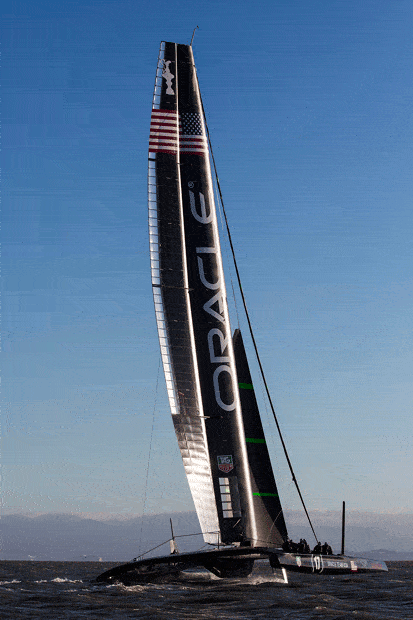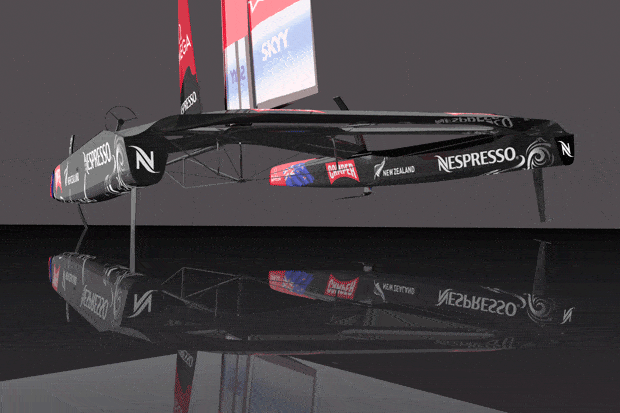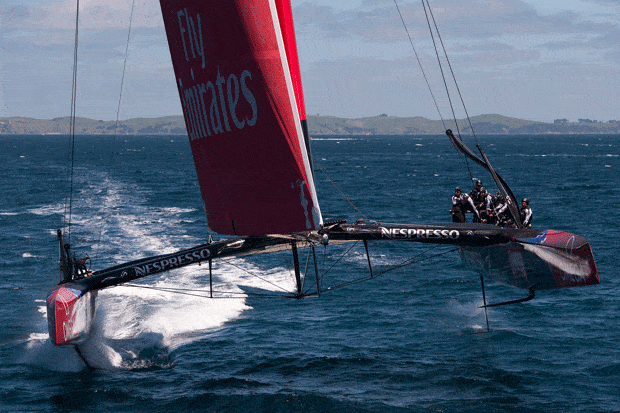
AC72
Calling the AC72 the most technologically advanced sailboat is not hyperbole. Upwind, on their slowest point of sail, the 72-foot catamarans can hit 25 knots, speeds well above the outright capabilities of most sailboats. Downwind, the AC72s fly on impossibly narrow foils, going so fast that through the jibes the wind passes around the bow, rather than the stern.
But this giant technological leap has come at a price: The financial resources required to design, build, and develop the new boats is tremendous, and has kept all but four teams—three sponsored by billionaires—from competing. Even more significant, at the time of this writing, the AC72s had suffered two catastrophic capsizes, the latter ending with the tragic drowning of British double Olympic medalist Andrew Simpson.
Catamarans are not new to the America’s Cup. Dennis Conner campaigned the wing-sailed Stars & Stripes to victory in San Diego in 1988, while Alinghi 5 was beaten handily by BMW Oracle Racing’s trimaran during the 33rd America’s Cup off Valencia, Spain. But those Deed of Gift matches were all about speed. The specified courses were either two or three legs and 40 miles long.
The 34th Cup is the first time in the event’s history twin-hulled vessels will be used by mutual consent between the defender and challenger of record.
Winning this Cup, on inshore, multiple-lap courses constricted by artificial course boundaries will require a boat that is as nimble as it is fast.
“Maneuvering speed is a very big part of it,” says Artemis Racing’s Tom Schnackenberg, whose America’s Cup experience dates back to the 12-Metres. “You lose several boatlengths in a good tack and more in a bad tack. Race modeling and working out the time around the course has been a big part of the design process.”
Nonetheless, it’s the shocking speed that even the most casual spectator will instantly appreciate. And that speed has two vital components: the 130-foot rigid wing sail that powers the boat, and the groundbreaking foils that—when going downwind—lift both hulls clear of the water, at the same time.
Wing efficiency
The rigid wing sails fitted to the AC72s are similar to an aircraft wing, but there are differences, starting with their vertical orientation. An aircraft wing only needs to generate lift in one direction. The AC72 wings must be capable of generating lift on either side, so the wing components are symmetric and the mechanics doubly as complex.
The AC72 wings typically have—working front to back—a main element, an optional hinged tab off the back of the main element, a slot, and then a series of flaps that form the wing’s trailing edge.
Camber—basically the depth in the sail—is created by hooking the aft section to windward. The greater the angle between the two elements, the more power the sail can generate, but like an airplane wing, only so much camber can be put in before the sail stalls.
The angle of the rear flaps, relative to one another vertically, determines the twist, which allows the rig to match the difference in the apparent wing angle between the top and the bottom of the wing, and plays a key role in depowering the sail. On some wings—Emirates Team New Zealand’s second wing being one example—twist can also be induced up the length of the front element.
A tab on the trailing edge of the forward element—Oracle Team USA’s wing has one, for example, ETNZ’s does not—helps smooth out the camber, but at the price of an added level of complexity.
Vital to the efficiency of the wing is the slot, which allows wind from the high pressure windward side of the wing to blast through to the leeward low pressure side, enabling flow to remain attached over more of the wing’s surface area. This raises the wing’s lift coefficient, making it more powerful downwind compared to an equivalent soft sail. But the design is complicated as regulating the size of the slot is essential: Upwind the slot is nearly closed, while downwind, when there is more camber in the wing, it is open.
In the buildup to this Cup, wings have taken some criticism. They are cumbersome, if not dangerous, to step and take down, and heavy. Oracle Team USA design team member Tom Speer, a former Lieutenant Colonel with the U.S. Air Force, says keeping the weight of the solid wing close to that of a similar soft-sail set up—as they were able to do with the 223-foot wing used in the 33rd America’s Cup—is the most significant challenge in building a rigid sail.
If these disadvantages can be tolerated—a very capable shore crew is a must—they bring a wealth of advantages over soft sail rigs.
First, compared to conventional mast and sail combinations, wings are vastly more efficient aerodynamically and create less drag. The lift coefficient, used to rate the efficiency of a wing, for an AC72 wing is around 2 to 2.5. The lift coefficient for a state-of-the-art traditional sail set up is approximately 1.5 to 2.
“Basically a soft sail rig can be comparable to a wing sail section at a particular operating point,” says Speer, “but the wing does much better at conditions away from there. It operates over a much broader range, and as the wind is always fluctuating, that is important. It has a higher maximum lift as well.”

As the leech tension of the sail is inherent in the wing’s rigid structure, the mainsheet load is a fraction of that of a conventional rig, which reduces the amount of structure required in the catamaran’s aft crossbeam.
If trimmed properly, the wing is less inclined to stall. And there’s no luffing through tacks. “Normally [through a tack] you have 70 degrees of dead zone in a soft sail,” says Oracle Team USA designer Joseph Ozanne. “You don’t have this zone at all with the wing. You always have lift unless you are exactly head to wind. So it is very powerful during a maneuver.” Modern sailcloth may stretch minimally, but the wing, with its wider cross section is still more stable, allowing better repeatability of settings with a minimum of sail controls.
There are three primary controls for the wing. The traveller, which is often referred to as the mainsheet, controls the overall rotation of the wing and its angle of attack relative to the wind. The camber control dictates the depth of the wing. Pulling it tighter will flatten out the fore and aft elements, while easing it off puts more depth into the sail, just like an outhaul. Twist control adjusts the vertical alignment of the flaps along the wing’s trailing edge. Pulling on the twist control straightens the trailing edge, while easing it off allows the upper flaps to fall progressively farther to leeward.
Another advantage of the wing sails may seem counterintuitive. Being solid, with a fixed area, it would seem logical that as the wind strength increases wings get increasingly overpowered and hard to manage. In fact, this isn’t what happens. Using the wing’s twist control, the top flaps can be feathered, lowering the center of effort of the wing. It’s not much different than reefing a soft sail, except it’s much faster and infinitely variable.
Flying on foils
As advanced as the wing sails are, they’re not the most talked-about technological development on the AC72s. That honor goes to the foils, which generate enough vertical lift that the boats become airborne while sailing off the wind. Once airborne, the speed difference, compared with boats that do not foil, is noticeable.
“On paper we knew it would probably be better,” says Emirates Team New Zealand designer Guillaume Verdier of the foiling AC72. “From the start we tried both options.”
In this respect, the campaigns did not come out of the blocks equally fast. Artemis Racing’s first AC72 was not designed to foil. That boat was rendered all but obsolete during Artemis’s first extensive tuning sessions against Oracle Team USA’s foiling boat last February.
“We figured it wasn’t as important as it’s turned out to be,” says Schnackenberg. “The rule looked like it was conspiring against foiling, but it turns out that the way that it has been interpreted, you can.”
Since that time Artemis Racing has been trialing new foil shapes on its AC45. The team’s second AC72, which had yet to be sailed at press time, is expected to be an airborne one.
For Oracle Team USA, foiling was a natural evolution of the technology utilized by the large French offshore multihulls for more than a decade.
“Lifting the boat and reducing hull volume are natural gains for multihulls,” says Ozanne, a French aero/hydrodynamicist who joined Larry Ellison’s team in 2004. “Given the wind conditions and the power of the boat, it became apparent that we could lift totally the [leeward] hull out of the water.”
Once foiling was on the table, the most significant problem for all the teams became the design of the daggerboards, which need to essentially serve two masters, providing horizontal lift to combat leeway when sailing upwind and vertical lift when sailing downwind.
Further complicating the process was the AC72 rule makers’ bid to prevent AC72s from getting fully airborne. Vital to foiling successfully is being able to do so in a stable manner, so that the amount of vertical lift generated by the foils decreases as the boat rises farther out of the water. On foiling Moths, for example, a wand on the bow senses the height of the boat and adjusts accordingly a lateral trim tab on the daggerboard. Such trim tabs are prohibited by the AC72 rule.
But this has not stopped the design teams. The foils used on the AC72s have evolved a considerable way from the C-shaped boards first introduced a decade and a half ago on ORMA 60s (and currently still used on Nacra 17 and A-Class cats). The C-shaped board has a couple of significant flaws, notably the lower the board, the more vertical lift it generates. The famous S-shaped boards originally used on Alinghi 5 in the 33rd America’s Cup neatly solved this problem, the shape of an ‘S’ causing the board to become more vertical as it was lowered, minimizing leeway upwind.
For this America’s Cup, while trim tabs may be banned, there is still considerable flexibility in what teams can do with their boards. The AC72 rule allows these boards not only to be raised and lowered but to be canted laterally inboard, increasing their dihedral, and also for the overall pitch of the board (fore and aft rotation) to be altered. The big challenge for design teams has been working out the best shape to prevent leeway upwind and create stable, controllable vertical lift downwind, so that the boat has heave stability, meaning it can fly in equilibrium, neither launching nor nose-diving.
The best heave stability is found in foils with dihedral, such as the V-foils typically used on hydrofoil ferries, where flying equilibrium is achieved simply because the higher the out-of-the-water vessel moves, the less foil is in the water to provide vertical lift. However, the downside of such foils is excess drag and weight.
So the most popular foil configuration seen on the AC72s are variations on the L-shaped daggerboard, with the vertical part of the L preventing leeway, and the horizontal part providing upward lift.

The problem with a pure 90-degree turn, as with the foil that Oracle Team USA’s AC72 was using when it capsized last October, is its poor heave stability. “A pure L is good in terms of drag, but you can’t control it,” says multihull designer and foil expert Martin Fischer.
One solution is to put a bend in the top of the daggerboard. By virtue of the bends, these boards are principally vertical when fully lowered, but cant inward, and provide vertical lift when slightly retracted. In effect the L shape becomes more of a V, which provides much improved heave stability.
But beyond this there has yet to be much consensus among the teams. Thanks to catamarans having twin hulls, teams have often trained with a different type of board in each hull to gain valuable data on the characteristics of each.
Of course, while the shape of the board is vital for its orientation and in turn its horizontal lift, vertical lift, and heave stability characteristics when it is raised or lowered, crews can also control these factors by canting and changing the pitch of the boards.
The specifics of each team’s daggerboard configurations, in particular how they alter the cant and pitch of the boards, are among the most closely guarded secrets of this Cup cycle.
Building daggerboards capable of handling the vertical loads, both static and dynamic, plus giant side loads created by a boat careering along at 40-plus knots is no small task, either.
“They are complex pieces of engineering because they have to withstand the entire weight of the boat,” says Ozanne, “7.7 tons of vertical load, and up to around 3.3 tons of side force, all on this little piece of carbon.”
Beside the intricacies of how to make the AC72 foil in a controllable manner, there is the issue of when to make the boat fly. It may seem mundane, but could prove pivotal, especially if the wind limits for racing are lowered. AC72s don’t foil upwind because doing so would result in too much leeway. But there will be times when they won’t foil downwind because there isn’t enough wind. The average wind speed for San Francisco Bay is quite high throughout the summer months, so this might not be an issue. Each team will have to make a call on the wind strength above which they wish to foil and design their boats, and their foils, to that. “If people choose a higher speed, then they’ll probably wind up with a higher top speed,” says Schnackenberg, “but it will also mean that they struggle a bit more when it’s light.”
At press time, there was less than seven weeks remaining to the start of the Louis Vuitton Cup—and just over three months to the Cup match itself—and while each team has made remarkable progress considering this class didn’t exist two years ago, one gets the impression from the teams that they have barely scratched the surface with this technology. There are still significant leaps to make.









